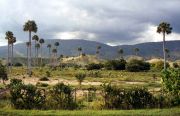There were two faces of Cuba. One reserved for tourists, artificial and plastic, where locals had no access unless they worked at the expensive resorts. The other was warm-hearted and welcoming everyday local Cuba, where making friends was instantaneous.
|
The Cubanos were exceptionally friendly. They approached visitors with purity and natural way that it was breathtaking. And they were all beautiful. The women were so feminine and natural and dressed with great taste. And the guys were athletic and cheerful. There was much poverty on the island, but people nevertheless went on with a smile. In Baracoa, I met a boy, who was apparently the national champion in free style wrestling, yet the state did little to compensate his brilliant dedication to the homeland. His mother was unemployed and his dad was making $7 a month. He was attending the University of Guantanamo. Every time he was visiting his parents, he had to bring some money so his mother could cook him dinner. He asked me if I could give him a t-shirt as a souvenir. I gave away half of my luggage... I was unimpressed that in the Casa de la Cultura, where I offered a few guys beer, they were really shocked, confessing that no-one had ever offered them a drink. What kind of tourists were visiting Baracoa?! A can of beer was $0.85 and a bottle of local rum was $2 or less, so it wasn’t expensive to make a little party and chat to the locals, who wanted to learn about the world and to practise their English.
I partied with the whole lot of locals until 4 am. It was great. I am not sure what language was used the most, but I think it was Spanish, since the two girls, who joined the group last, insisted on Spanish. I wasn’t that fluent in Spanish, and even if I was, it would still be harder to speak Cubano. They were using a lot of slang.
Of course, there were also the other kind of locals around. This kind had more to do with trading with tourists. They were trained to part the visitors with their dollars by selling cheap souvenirs, fake cigars and even under aged girls. Prostitution was illegal in Cuba and the police would stop any women talking to foreigners under the suspicion that they try to sell themselves (hence it was hard to make friends with local women).
|
|
| Favourite spots: |
Therefore, normally the ladies would avoid contact with male travellers. Even if they wanted to have an innocent chat. The only safe place for the encounters were Casas de la Trova or Casas de la Cultura. And one of those, Casa de la Cultura in Santiago de Cuba was my favourite spot. It was phenomenal. The live music played by a number of bands and the quality of singing were incredible. They were so professional! Also, part of the club was under open skies, which allowed for a fresh breeze. But the classical drinks served there in giant glasses (all priced $2.5, like everywhere else!) were fabulous. When I visited Santiago, it was Christmas Eve and the night was salient.
The casa was located near the grand Cespedes Park complete with magnificent mansions, some of which dating back to sixteenth century, a truly remarkable and picturesque piazza. Plus it was so near to the private house I was staying, too.
|
|
| What's really great: |
|
Music! It was completely inseparable from the Cuban life. The rhythm of samba, rumba, son, danzon, the cha cha could be heard everywhere. Literally! If it wasn’t played life in the afternoons in the streets, at the cabarets in the night, it was played by the bands in restaurants, clubs, culture houses all day long and simply blasting from the regular households. The Cubanos would dance to it, jump to it or simply just gently sway to it. Regardless of the place. And when they played it live, there was so much passion and emotion in their voices that they could hardly contain it. They were so good and professional that they could seriously compete with international megastars! Music was making the entire island happy. Truly happy! Making it an island of eternal carnival. People who say that the Cubanos are unhappy, lie. Surely the islanders would welcome more freedom and prosperity, but there were far from unhappy.
|
|
| Sights: |
Plus, the island was so pretty. The diversity of the landscape was unprecedented. Cuba being the largest of the Antilles, easily beat all other islands. There were mountains, beaches, valleys, cliffs, swamps, lakes, lagoons, palm groves... And all that in such a close vicinity of the island’s second city.
Then, if Santiago’s architecture were to be described in a word, it would have to be ‘eclectic’. This grand city combined art-deco to neoclassical, to renaissance, to even semi-baroque styles. It housed the island’s oldest church (1514), in the Cespedes Park, the Cuban Life Museum built in 1520 once was the conquistador Diego Velazquez’s mansion. There was also the Bacardi Museum illustrating how the family invented rum, almost by accident.
In the outskirts of the city there was El Morro, pirates’ fortress recently listed by UNESCO as a World Heritage Site. It was magnificent and the views from there were incredible.
|
|
| Accommodations: |
|
Although it had been increasing, the number of hotels on the island was still very small. The number of hostels was even smaller! Surely, there were more and more expensive resorts growing on the beaches and lagoons, but they were so sad that the natives were not allowed in entire cities, like Varadero, unless they worked there. The huge socialistic structures from 1960s and 1970s in all the main cities were dirty and extremely bad value for money. For about $40 a night, there would be no electricity and and no hot water. The solution was to stay at private homes - casa particular. Their prices were about $10 per night for a room with a hot shower and in homey ambiance. The Cubanos would make sure visitors felt welcome in their houses. Furthermore, it was the best way to get closer to the Cuban real, everyday life.
|
|
| Nightlife: |
 |
 |
 |
 |
 |
 |
 |
 |
Between Santiago and Guantanamo
 |
 |
Cuba most definitely knew how to party. There was no question about it. Santiago was very special, since it had many pubs, clubs, drinks bars and cultural houses, which all gave life music performances, cabarets, etc. There were two distinctive places on Cuba, which guaranteed entertainment. One of them was casa de la trova, whose term related to ‘troubadour’, a performer or entertainer. These places, designed as a meeting place for music lovers, had stages for the shows and often had fully licensed bars, selling all classical Cuban rum-based drinks, invariably priced at $2.5 per glass. Each town would have one plus one casa de la cultura, which would also have music performances plus some drama and other entertainment. In Santiago, apart from these two, there were also the Casa de la Musica, Casa de los Tradiciones, and Patio de los dos Abuelos. And all were superb. Actually, the Casa de la Trova, which was perhaps over advertised, impressed me least. It was still excellent though!
|
|
| Hangouts: |
Calle Heredia with many drink bars and clubs, which were open late, would be one of the places to hang out. It was always packed with travellers and the locals trying to make contact, some of them selling stuff. The bars would open in the afternoon. So, in the morning and early afternoon one of the good places to sit down and watch the life go by, would be the hugely attractive Parque Cespedes and alleys leading from it, lined with pastel-hued houses, which in comparison with other Cuban cities, looked almost like new. There were also other, smaller piazzas and view points over the city, harbour and beaches. Playing with kids wandering on the streets and taking their photos with a small Polaroid camera and given the snaps away was my favourite activity.
Beyond Santiago was the El Uvero hill where a small museum with expositions on early stages of the Cuban revolution. The surroundings were stunning, including black beaches on the way.
|
|
| Restaurants: |
|
Similarly to the accommodation situation, state-owned restaurants around the country were very bad. With the exception of a few in the capital, even fewer in Santiago and Cienfuegos, the restaurants’ menus were short and the cooks seemed to be complete strangers to spices. The dishes would be overcooked and served semi-cold. Brrr. Again, the solution was private eateries called paladores. Some of them operated legally and some didn’t. The greatest thing about the paladores was that they had lobsters! Officially, lobsters were reserved for export only and it was illegal to sell on the domestic market. However rules were relaxed to allow internal export, so the owners just needed to take details of the foreign passports and this way it was OK to fee the visitors with shellfish. For mere $7 huge grilled lobster would land on the table. And $8 it would buy lobster accompanied by potatoes, beans, rice, fries, salad, juice, fresh fruit. Santiago and even small villages had a few paladores.
|
|
| Other recommendations: |
I rented a car, so it was easy for me to get everywhere. Petrol however was an issue. It was generally not available. The Cubanos needed to have special petrol coupons if they wanted to buy some gasoline. But even then petrol was not available on every filling station. So, as a rule of thumb, one should fill up on every station it was available. It happened to me that the poor Fiat nearly dried out completely. On several stations in a row, the said ‘no hay gasolina’ and I believed them, but it was not always entirely accurate. Unofficially, if one had good negotiation skills, petrol was almost always available from the station manager. For a small tip!
Asking directions on Cuba was also tricky. The roads were equipped with few meaningful signed and instead of signs showing directions to towns, they showed ‘Biotechnologia’ for example. When asking locals, one should not use yes/no questions, which were invariably answered ‘yes’, Instead of ‘Is this...’ use ‘Where...?’, ‘Which...?’
|
|
Published on Sunday April 6th, 2008
|
|
 Publish on Facebook
Publish on Facebook
|
Fri, Apr 25 2008 - 05:04 AM
 by jorgesanchez
| 5 stars is the minimum that I can give you! |
Tue, Apr 15 2008 - 06:39 AM
 by ravinderkumarsi by ravinderkumarsi
| wow , another great addition to the krys series of report |
Mon, Apr 07 2008 - 10:29 AM
 by rangutan by rangutan
| Another excellent description of life outside our weird westernerised world. [4.7] |
Mon, Apr 07 2008 - 09:46 AM
 by davidx by davidx
| A particularly good time to be writing about Cuba. |
| Information: |
| Login if you are a member, or sign up for a free membership to rate this report and to earn globo points! |
|
| Albania |
|
|
|
|
|
|
 |
| Antigua and Barbuda |
|
|
 |
| Argentina |
|
|
|
|
|
|
 |
| Armenia |
|
|
 |
| Aruba |
|
|
 |
| Australia |
|
|
 |
| Austria |
|
|
 |
| Azerbaijan |
|
|
 |
| Barbados |
|
|
 |
| Belgium |
|
|
|
|
|

|
